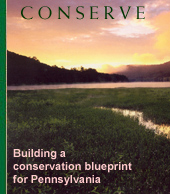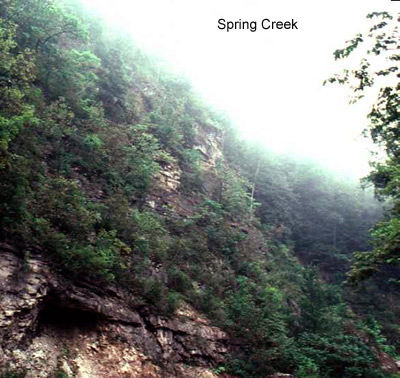















The Gatesburg Formation
This bedrock layer was formed during Earth's Cambrian Period, which means when exposed at the surface these are some of the oldest rocks you can find in the state. The Gatesburg consists of sublayers of sandstones, limestones and dolomites (limestone with magnesium). Because of its sand, gravel and limestone nature, the resulting subsoils are coarse and very well drained, yet with some calcium content. Iron deposits in the Gatesburg drew steel magnate Andrew Carnegie to mine certain areas here in the 1880s.
View a map of the conservation priority areas.
|
| |
Nittany Valley
Nittany Valley is the intermountain region of Centre and Huntingdon counties, lying between Tussey Mountain and Bald Eagle Mountain, and drained by Spruce, Spring and Little Fishing creeks. It is significant because of its underlying geology of the Gatesburg and limestone bedrock formations.
Nittany Valley lies precisely at the geographic center of Pennsylvania in Centre and Huntingdon counties between two long mountain ridges: Bald Eagle Mountain and Tussey Mountain. Biodiversity significance is not as much on these mountains, as within the intermountain lowlands. Here the bedrock geology is composed of multiple limestones and the rare gravelly Gatesburg Formation.
This is one of the most unique landscapes in the state and includes a mixture of pitch pine-scrub oak sand barrens habitat, dotted with vernal pools; the Spring Creek valley with its alkaline soils, limestone cliffs and rich vegetation; karst (cave permeated) valleys underlain with limestone aquifers, sinkholes and solutional caves. The outflows from groundwater reserves form some of the largest natural springs in the region and are the source for high-quality streams such as the cold and clear Spruce Creek. These unusual ecosystems harbor rare species, such as Stellmack’s cave amphipod and Franz’s cave isopod, crustaceans known from few other places on Earth.
Large intact forests exist on the adjacent mountains, but lower limestone soil-based forests are essentially not present due to a high degree of fragmentation related to agriculture, highways and expanding development. The conservation of biodiversity in Nittany Valley brings its own set of particular challenges to protecting and restoring its signature life forms and ecosystems. One particular challenge will be to assure viability by restoring lowland forests in certain areas to larger size patches and to create corridors for wildlife. Protecting groundwater quality and reducing fragmentation are other conservation goals.

Key Features
• Spring Creek valley: ecologically diverse forests with limestone slopes and cliffs
• The Barrens: pitch-pine scrub oak barrens and numerous vernal pools
• Spruce Creek: karst (cave permeated) valley, springs and a subterranean ecosystem
Conservation Targets
• Six important ecosystems: vernal pools, caves, limestone springs, limestone cliffs, barrens, alkaline creeks, etc.
• 22 occurrences of globally rare plants, invertebrates and vertebrates including the northern metalmark butterfly and the golden-winged warbler.
• Four Biological Diversity Areas totaling 13,400 acres and harboring species and ecosystems above
• 17 miles of important stream ecosystems
Partners
Clearwater Conservancy
The Pennsylvania State University
Pennsylvania Game Commission
|
|
| |
View the next conservation priority area: Juniata River Basin
|
|

